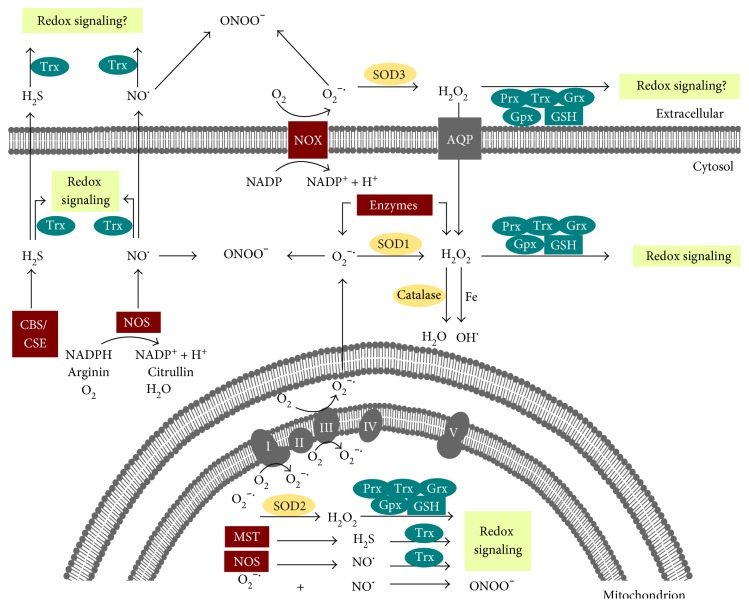Figure 2.
Redox regulation is enzymatically controlled. Illustration of cellular and extracellular enzymes that (i) generate redox active species (red), (ii) decompose reactive species, and are classified as antioxidants (yellow) or (iii) participate in redox signaling (blue). In the cytosol, superoxide (O2−) and hydrogen peroxide (H2O2) can be produced by specific enzymes; the cytosolic SOD1 can convert O2− to H2O2. Moreover, the NADPH and oxygen-dependent membrane protein NADPH-oxidase (NOX) can produce O2− that is converted to H2O2 by extracellular SOD3. The latter can cross the membrane via simple diffusion and aquaporins. H2O2 can participate in cell signaling as a second messenger via the action of the thioredoxin family members peroxiredoxin (Prx), thioredoxin (Trx), glutaredoxin (Grx), and glutathione peroxidases. These enzymes are NADPH- and mostly glutathione- (GSH-) dependent. H2O2 can also be reduced to water by the peroxidase catalase, which is mainly located in peroxisomes. However, in the presence of free iron, the highly reactive and damaging hydroxyl radical (OH•) is formed from H2O2 via the Fenton reaction. Nitric oxide (NO) is generated by cytosolic NO-synthase (NOS) and hydrogen sulfite (H2S) by the enzymes cystathionine β-synthase (CBS) and cystathionine γ-lyase (CSE). Both constitute second messengers that can participate in redox signaling via the action of Trx. Note that peroxynitrite (ONOO−) can spontaneously form in the presence of O2− and NO, inducing irreversible modifications of various biomolecules and thus not participating in redox signaling. In mitochondria, complexes I and III of the mitochondrial respiratory chain produce superoxide (O2−•). Superoxide dismutase 2 (SOD2) converts O2− to H2O2. Mitochondrial NOS and 3-mercaptopyruvate sulfurtransferase (MST) produce NO and H2S, respectively. Mitochondrial H2O2, NO, and H2S can participate in redox signaling. Similar to the cytosol, ONOO− and OH• can also be formed in the mitochondria. In the extracellular environment, NOX and SOD3 produce O2− and H2O2 and the intracellularly produced NO and H2S can cross the plasma membrane. Members of the Trx family of proteins are found extracellular. Therefore, the intracellular concept of redox signaling might also occur in the microenvironment of the cell.

